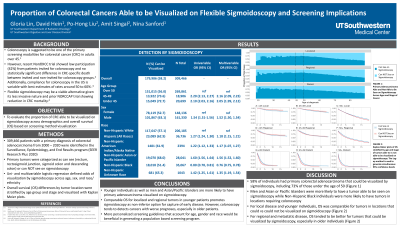Monday Poster Session
Category: Colorectal Cancer Prevention
P1770 - Proportion of Colorectal Cancers Able to Be Visualized on Flexible Sigmoidoscopy and Screening Implications
Monday, October 23, 2023
10:30 AM - 4:15 PM PT
Location: Exhibit Hall

Has Audio

Gloria Lin, MD
UT Southwestern Medical Center
Dallas, TX
Presenting Author(s)
Gloria Lin, MD, David Hein, BS, Po-Hong Liu, MD, MPH, Amit G. Singal, MD, MS, Nina Sanford, MD
UT Southwestern Medical Center, Dallas, TX
Introduction: Colonoscopy is touted as the gold standard for colorectal cancer (CRC) screening; however, adherence is suboptimal. Flexible sigmoidoscopy, supported by randomized data showing reduction in CRC mortality, requires less bowel preparation as well as sedation which may be more desirable for patients undergoing screening. We sought to evaluate the anatomic distribution of CRC to calculate the proportion that could be visualized with sigmoidoscopy and determine patterns in demographics as well as prognosis.
Methods: Patients with a primary diagnosis of colorectal adenocarcinoma were identified in the SEER program (2000-2020). Tumors from the rectum to descending colon were categorized as able to be seen on sigmoidoscopy, while those more proximal required colonoscopies. The proportions of tumors that could be seen with sigmoidoscopy versus only by colonoscopy were reported and analyzed across demographics. Differential prognoses between tumor locations stratified by age groups and stages were assessed via the difference in overall restricted mean survival time (RMST) at 2, 5, and 10 years.
Results: Among 309,466 patients, 58% had tumors that could be visualized by sigmoidoscopy, including 73% of those under age 50 (OR 2.20 95% CI 2.13-2.27 for age 45-49, OR 2.10, 95% CI 2.03-2.16 for age < 45 versus >50). Other variables positively associated with having tumors that could be visualized on sigmoidoscopy included male sex (OR 1.54, 95% CI 1.51-1.56 vs Female) and Asian or Pacific islander race (OR 1.60, 95% CI 1.56-1.64). In all age groups and local disease, RMST was comparable for tumors in locations that could vs could not be visualized on sigmoidoscopy. In contrast, for regional and metastatic cancer, RMST tended to be better for tumors that could be visualized by sigmoidoscopy across age groups.
Discussion: Most CRC arises in locations detectable by flexible sigmoidoscopy, particularly in younger patients and in select populations including based on sex or race. There also did not appear to be a major difference in survival between local tumors that could and could not be seen on flexible sigmoidoscopy, signifying the value of flexible sigmoidoscopy as a screening tool to capture early cancers in certain populations. Overall, flexible sigmoidoscopy remains an efficacious option for CRC screening in patients who are reluctant to undergo colonoscopy or in areas with limited colonoscopy capacity.
Disclosures:
Gloria Lin, MD, David Hein, BS, Po-Hong Liu, MD, MPH, Amit G. Singal, MD, MS, Nina Sanford, MD. P1770 - Proportion of Colorectal Cancers Able to Be Visualized on Flexible Sigmoidoscopy and Screening Implications, ACG 2023 Annual Scientific Meeting Abstracts. Vancouver, BC, Canada: American College of Gastroenterology.
UT Southwestern Medical Center, Dallas, TX
Introduction: Colonoscopy is touted as the gold standard for colorectal cancer (CRC) screening; however, adherence is suboptimal. Flexible sigmoidoscopy, supported by randomized data showing reduction in CRC mortality, requires less bowel preparation as well as sedation which may be more desirable for patients undergoing screening. We sought to evaluate the anatomic distribution of CRC to calculate the proportion that could be visualized with sigmoidoscopy and determine patterns in demographics as well as prognosis.
Methods: Patients with a primary diagnosis of colorectal adenocarcinoma were identified in the SEER program (2000-2020). Tumors from the rectum to descending colon were categorized as able to be seen on sigmoidoscopy, while those more proximal required colonoscopies. The proportions of tumors that could be seen with sigmoidoscopy versus only by colonoscopy were reported and analyzed across demographics. Differential prognoses between tumor locations stratified by age groups and stages were assessed via the difference in overall restricted mean survival time (RMST) at 2, 5, and 10 years.
Results: Among 309,466 patients, 58% had tumors that could be visualized by sigmoidoscopy, including 73% of those under age 50 (OR 2.20 95% CI 2.13-2.27 for age 45-49, OR 2.10, 95% CI 2.03-2.16 for age < 45 versus >50). Other variables positively associated with having tumors that could be visualized on sigmoidoscopy included male sex (OR 1.54, 95% CI 1.51-1.56 vs Female) and Asian or Pacific islander race (OR 1.60, 95% CI 1.56-1.64). In all age groups and local disease, RMST was comparable for tumors in locations that could vs could not be visualized on sigmoidoscopy. In contrast, for regional and metastatic cancer, RMST tended to be better for tumors that could be visualized by sigmoidoscopy across age groups.
Discussion: Most CRC arises in locations detectable by flexible sigmoidoscopy, particularly in younger patients and in select populations including based on sex or race. There also did not appear to be a major difference in survival between local tumors that could and could not be seen on flexible sigmoidoscopy, signifying the value of flexible sigmoidoscopy as a screening tool to capture early cancers in certain populations. Overall, flexible sigmoidoscopy remains an efficacious option for CRC screening in patients who are reluctant to undergo colonoscopy or in areas with limited colonoscopy capacity.
Disclosures:
Gloria Lin indicated no relevant financial relationships.
David Hein indicated no relevant financial relationships.
Po-Hong Liu indicated no relevant financial relationships.
Amit Singal: Ascelia – Consultant. AstraZeneca – Consultant. Bayer – Consultant. Boston Scientific – Consultant. Eisai – Consultant. Exact Sciences – Consultant. Exelixis – Consultant. Freenome – Consultant. FujiFilm Medical Sciences – Consultant. Genentech – Consultant. Glycotest – Consultant. Histosonics – Consultant. Universal Diagnostics – Consultant. Verve – Consultant.
Nina Sanford indicated no relevant financial relationships.
Gloria Lin, MD, David Hein, BS, Po-Hong Liu, MD, MPH, Amit G. Singal, MD, MS, Nina Sanford, MD. P1770 - Proportion of Colorectal Cancers Able to Be Visualized on Flexible Sigmoidoscopy and Screening Implications, ACG 2023 Annual Scientific Meeting Abstracts. Vancouver, BC, Canada: American College of Gastroenterology.
